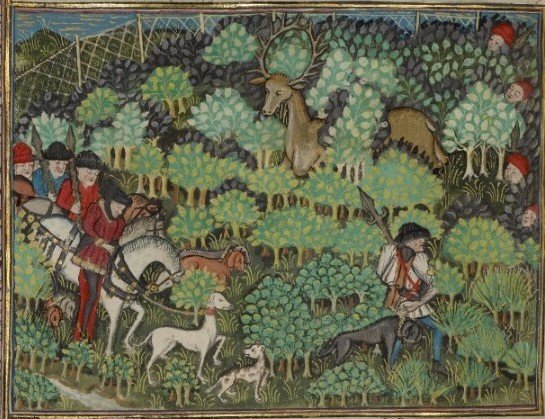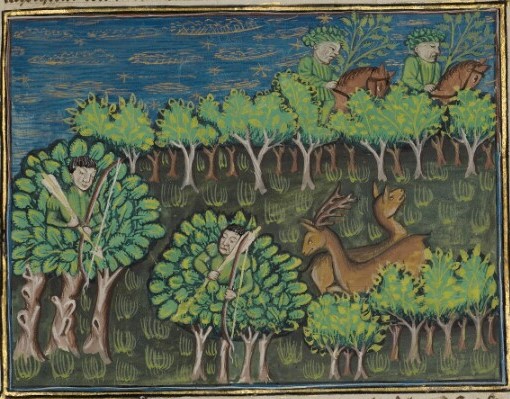Fables—short moralized narratives, often with animal subjects, associated with the legendary figure of Aesop—have been transmitted and adapted from antiquity down to the present. In the Middle Ages, fables were used to teach Latin to children. One particular fable collection, sometimes called the “elegiac Romulus” for its verse form and supposed dedicatee, seems to have been especially popular in this regard. This collection of approximately 60 fables (many manuscripts have 58 but others may have several more) is extant in almost 200 manuscripts from the thirteenth to sixteenth centuries. Some of these manuscripts show signs of use in the classroom (i.e., they have features such as glosses, words numbered to aid in parsing, etc. An edition by Aaron E. Wright reproduces one such manuscript).[1] There is a critical text of the elegiac Romulus edited by Paola Busdraghi, with a translation into Italian.[2] I offer below my own English translation of one fable from the elegiac Romulus, along with brief commentary.
The fable of The Stag and the Dogs (De cervo et canibus), 74 in the Perry Index, is also known as The Stag at the Spring (Cervus ad fontem)[3] or The Stag and His Antlers (De cervo et cornibus eius).[4] Other medieval versions of this fable are found in prose and verse Latin fable collections in the Romulus tradition;[5] the Parabolae of Odo of Cheriton;[6] the Novus Aesopus of Alexander Neckam;[7] and the Fables of Marie de France.[8]
In this fable, a stag views his own reflection in the spring he drinks at, proud of his many-tined antlers, but critical of his legs, which seem to him too slender. The stag flees as hunting dogs approach, now appreciating the swiftness of his legs, but his antlers become entangled as he passes through dense vegetation, and he is caught and killed. The moral typically advises that we should value or disdain things according to whether they help us or harm us.

Here is the version of the fable found in the elegiac Romulus, from Busdraghi’s edition:[9]
De cervo et canibus
Fons nitet argento similis, sitis arida cervum
huc rapit, haurit aquas, se speculatur aquis.
Hunc beat, hunc mulcet ramose gloria frontis,
hunc premit, hunc ledit tibia macra pedum.
Ecce canes, tonat ira canum. Timet ille, timenti
fit fuga, culpati cruris adorat opem.
Silve claustra subit, cornu retinente moratur:
crure neci raptum cornua longa necant.
Spernere quod prosit et amare quod obsit ineptum est:
prodest quod fugimus et quod amamus obest.
The following is my translation:
The stag and the dogs
A spring shines like silver, dry thirst draws a stag
to the place; he drinks the waters, watches himself in the waters.
The glory of his branching brow gladdens and delights him,
his thin shins and feet depress him, annoy him.
Here come the dogs, the rage of dogs resounds. He is afraid, and, fearing,
takes flight, admires the aid of his once-blamed legs.
He comes into a narrow grove, is delayed by horns holding him back:
snatched from death by his legs, but killed by his long antlers.
It is absurd to despise what benefits you and love what hurts you:
what we flee helps us, and what we love hinders us.
Medieval literature often gives an impression of hunting as a pastime of the aristocracy. And indeed, it was—or at least the practice of pursuing and killing red deer (Cervus elaphus) using a pack of hunting dogs, as this fable depicts, was the “noblest” (at least according to aristocratic hunters!) and most highly ritualized form of hunting in the Middle Ages. Hunting was, however, “central to the lives of all classes,”[10] and involved, as it still does today, killing a wide range of species using a variety of methods, such as stalking, snaring, and netting—quite effective, but nevertheless disdained by some elite medieval authors as unsporting. Another way of hunting deer was the “bow and stable” method, in which deer (red or fallow) were driven towards a line of archers.[11] This is the type of deer hunting depicted in Sir Gawain and the Green Knight (previously discussed on the MSRB). Unlike the hunt par force de chiens—the hunt of a single animal with a pack of dogs—this method could result in numerous kills.

There is a ring of truth to the stag’s fate in The Stag and the Dogs: in a sense, the stag’s glorious antlers doom him. While a substantial rack of antlers is both a means of competing against other males for mates and an effective defense from many non-human predators, it was precisely the antlers which marked a stag, or hart, as legitimate quarry. The Master of Game, an early-fifteenth-century English translation of Gaston Phoebus’s hunting treatise, the Livre de la chasse, provides precise terminology for male deer in each year of their life. A stag in his sixth year, having at least ten tines on his antlers, was a “hart of ten”; at this point the animal could be pursued. But scouts for a hunting party would attempt to find not just any hart who could be pursued; ideally the party would seek “the finest hart available in the area.”[12] In modern times, as well, some hunters of deer may go for the most impressive “trophy” specimens—males in their prime with sizeable racks—rather than targeting more vulnerable animals, as predators such as wolves are inclined to do. This may have deleterious effects on deer populations.[13]
The fable of The Stag and the Dogs does not function as an indictment of hunting. This narrative fits within a larger context of interspecies violence throughout the fable genre, in which characters die as a consequence for their vices or errors. Nonetheless, rather than focusing attention on humans’ pleasure in hunting deer, as many other medieval works on the topic do, the fable invites readers to briefly consider the predicament of the frightened victim, while at the same time making a lesson out of his misjudgment.
Linnet Heald
PhD in Medieval Studies
University of Notre Dame
[1] Aaron E. Wright, ed., The Fables of ‘Walter of England’ Edited from Wolfenbüttel, Herzog August Bibliothek, Codex Guelferbytanus 185 Helmstadienis (Toronto: Pontifical Institute of Mediaeval Studies, 1997).
[2] Paola Busdraghi, ed., L’Esopus attribuito a Gualtiero Anglico, Favolisti latini medievali e umanistici, 10 (Genova: Università di Genova, 2005).
[3] Francisco Rodríguez Adrados, History of the Graeco‐Latin Fable, trans. Leslie A. Ray, vol. 3: Inventory and Documentation of the Graeco-Latin Fable (Leiden: Brill, 2003), p. 625.
[4] Giovanni Garbugino, ed., Alessandro Neckam: Novus Aesopus, Favolisti latini medievali, 2 (Genova: Università di Genova, 1987), p. 124.
[5] Léopold Hervieux, ed., Les fabulistes latins depuis le siècle d’Auguste jusqu’à la fin du moyen âge, vol. 2: Phèdre et ses anciens imitateurs directs et indirects (Paris: Firmin-Didot, 1884).
[6] Léopold Hervieux, ed., Les fabulistes latins depuis le siècle d’Auguste jusqu’à la fin du moyen âge, vol. 4: Eudes de Cheriton et ses dérivés (Paris: Firmin-Didot, 1896).
[7] Garbugino, ed., Novus Aesopus, p. 124.
[8] Charles Brucker, ed., Les Fables: édition critique accompagnée d’une introduction, d’une traduction, des notes et d’un glossaire, 2nd ed. (Paris: Peeters, 1998), pp. 130-1.
[9] Busdraghi, ed., L’Esopus, p. 148.
[10] Tony Pollard, “Foreword,” in Medieval Hunting, by Richard Almond (Stroud: The History Press, 2011).
[11] John Cummins, The Hound and the Hawk: The Art of Medieval Hunting (New York: St. Martin’s Press, 1988), pp. 47-67.
[12] Cummins, The Hound and the Hawk, pp. 32-4.[13] Jos M. Milner, Erlend B. Nilsen, and Harry P. Andreassen, “Demographic Side Effects of Selective Hunting in Ungulates and Carnivores,” Conservation Biology 21, no. 1 (2007), pp. 36-47.




